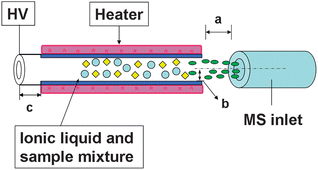Pesticides are necessary for effective crop production but their toxicity can pass onto consumers and cause dangerous health effects. Mass spectrometry continues to be the gold standard for pesticide residue testing by providing highly sensitive and specific tests for food safety. Although many versions of mass spectrometry have been applied to this field, there are still problems such as loss of sample, requiring high voltages, complex ionization preparation, and difficulty in heterogeneous solutions. To overcome these limitations, researchers at East China Institute of Technology and Nanchang University have coupled thermal dissociation atmospheric chemical ionization (TDCI) to linear trap mass spectrometry (LTQ-MS), for a more environmentally friendly pesticide detection technique. TDCI uses ionic liquids to create ions, instead of an external source, and the resulting solution exchanges charge with the thermally evaporated analytes. In order to test the capabilities of TDCI, a common pesticide, dimethoate, was measured in highly viscous solutions, fruit juices. TDCI rapidly detected trace levels of dimethoate in a variety of fruit juices below the EU standardized levels for fruit and with high specificity.

Dissociation atmospheric chemical ionization (TDCI) source coupled with LTQ-MS
To know more about the study, click on the link below:
Thermal dissociation atmospheric chemical ionization ion trap mass spectrometry with a miniature source for selective trace detection of dimethoate in fruit juices
Yongzhong Ouyang, Xinglei Zhang, Jing Han, Xiali Guo, Zhiqiang Zhu, Huanwen Chen and Liping Luo
Analyst, 2013, Advance Article
DOI: 10.1039/C2AN36244A










